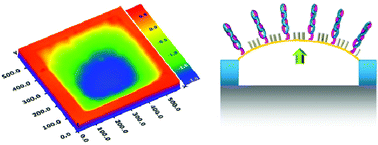Biomolecular detection with a thin membrane transducer
Abstract
We present a thin membrane transducer (TMT) that can detect nucleic acid based biomolecular reactions including DNA hybridization and

* Corresponding authors
a
School of Mechanical and Aerospace Engineering, Seoul National University, San 56-1, Shinlim, Kwanak, Seoul, Korea
E-mail:
jleenano@snu.ac.kr
Fax: +82 02 880 9101
Tel: +82 02 880 9101
b Department of Chemical Engineering, Dong-A University, Busan, Korea
c School of Chemical and Biological Engineering, Seoul National University, San 56-1, Shinlim, Kwanak, Seoul, Korea
d Institute of Advanced Machinery and Design, Seoul National University, San 56-1, Shinlim, Kwanak, Seoul, Korea
We present a thin membrane transducer (TMT) that can detect nucleic acid based biomolecular reactions including DNA hybridization and

 Please wait while we load your content...
Something went wrong. Try again?
Please wait while we load your content...
Something went wrong. Try again?
M. Cha, J. Shin, J. Kim, I. Kim, J. Choi, N. Lee, B. Kim and J. Lee, Lab Chip, 2008, 8, 932 DOI: 10.1039/B719101D
To request permission to reproduce material from this article, please go to the Copyright Clearance Center request page.
If you are an author contributing to an RSC publication, you do not need to request permission provided correct acknowledgement is given.
If you are the author of this article, you do not need to request permission to reproduce figures and diagrams provided correct acknowledgement is given. If you want to reproduce the whole article in a third-party publication (excluding your thesis/dissertation for which permission is not required) please go to the Copyright Clearance Center request page.
Read more about how to correctly acknowledge RSC content.
 Fetching data from CrossRef.
Fetching data from CrossRef.
This may take some time to load.
Loading related content
